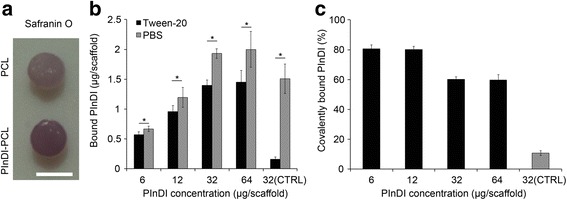Fig. 1.

Covalently conjugating PlnD1 to PCL scaffolds. Panel a shows qualitative confirmation of PlnD1 conjugation to PCL via Safranin O staining. Scaffold on the bottom was processed with Sulfo-NHS/EDC, which facilitated the reaction of free carboxylic groups on PCL with amines on PlnD1. Scaffold on the top was unmodified. To quantitatively determine the maximum amount of PlnD1 that could be conjugated to the PCL scaffold, scaffolds were incubated with 6.4, 19.2, 32, or 64 μg of PlnD1 per scaffold. PBS was used in place of NHS/EDC in the conjugation reaction for the control (CTRL) group. Panel b shows the amount of PlnD1 detected following a PBS wash, followed by another wash with 1 % Tween-20. The latter was employed to remove any non-specific binding of PlnD1 on the scaffold. c Covalently bound PInDI in PCL was defined as amount of PlnD1 left on the scaffold after the Tween-20 wash (covalently conjugated PlnD1) divided by the amount of PlnD1 on the scaffold after the PBS wash (includes both covalently conjugated and non-specific bound PlnD1) x 100 %. (n = 3) Error bars correspond to standard deviation. Scale bar = 3 mm in (a). (*) indicates a statistical difference between groups (p < 0.05)
